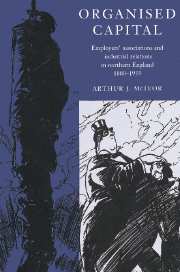Introduction
Published online by Cambridge University Press: 14 October 2009
Summary
The subject matter of this book lies within the intersection of business and labour history, emerging from a long-standing interest in the history of employer combinations, anti-labour organisations and management industrial relations strategies. For a relatively brief period, from the late nineteenth century to the Second World War, employers' organisations proliferated, and collectively formulated policies characterised the behaviour of most British employers in many spheres of industrial relations, social, economic and political activity. Before and after this phase, atomised, company-level bargaining and determination of labour relations predominated. Since the 1930s, the ability of employers' organisations in Britain to regulate industrial relations and control labour markets within their respective industries has significantly declined, and internalised, company-specific labour management structures and policies have become more important. This book thus explores the heyday of delegated, multi-employer relations with trade unions and collective regulation of the labour contract and labour markets, examining the genesis and evolution of employers' associations, the formulation of multi-employer labour relations strategies and the changing role of such institutions in British industrial relations over the period 1880–1939.
Such a fundamental process of change – from individualism and the free market to collective employer action and market regulation – merits extensive analysis and prompts at least four primary clusters of questions which are taken up in the pages that follow: first, what are employers' organisations and what is distinctive about the British variant?
- Type
- Chapter
- Information
- Organised CapitalEmployers' Associations and Industrial Relations in Northern England, 1880–1939, pp. 1 - 10Publisher: Cambridge University PressPrint publication year: 1996
- 1
- Cited by

